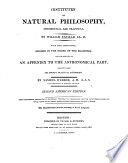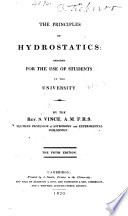 That the planets all move in elliptic orbits, of which the sun occupies one of the foci. 3. That the squares of the times of the revolutions of the planets are as the cubes of their mean distances from the sun. That the planets all move in elliptic orbits, of which the sun occupies one of the foci. 3. That the squares of the times of the revolutions of the planets are as the cubes of their mean distances from the sun.  A Complete System of Astronomy - Page 97by Samuel Vince - 1814Full view A Complete System of Astronomy - Page 97by Samuel Vince - 1814Full view - About this book
 | Colin MacLaurin - 1801 - 506 pages
...planet to the sun in equal times are equal, and the squares of the periodic times of the different planets are as the cubes of their mean distances from the sun (as was observed by the famous Kepler), and because the same laws obtain in the motions of the satellites... | |
 | Samuel Vince - 1811 - 260 pages
...again, he discovered his error, and found an exact agreement between them. Thus he discovered that famous law, That the squares of the periodic times...consequence of the motion of a body in an ellipse, revolving about the focus. Prin. Phil. Lib. I. Sec. 2. Pr. 15. The relative mean distances of the planets... | |
 | William Enfield - 1811 - 476 pages
...squares of those distances. It appears from observation, that the squares of the periodical times of the planets are as the cubes of their mean distances from the sun. For example, Saturn's periodical time being found to be to Jupiter's about as 30 to 12, and the distance... | |
 | Jedidiah Morse - 1814 - 696 pages
...portions of the space, contained within the planet's orbit. 2. " The squares of the periodical times ot the planets are as the cubes of their mean distances from the sun." That is, as the square of the time, which any planet takes to describe its orbit, is to the square... | |
 | Samuel Vince - 1820 - 472 pages
...again, he discovered his error, and found an exact agreement between them. Thus he discovered that famous law, That the squares of the periodic times...the planets are as the cubes of their mean distances Jrom the sun. Sir /. Newton afterwards proved that this is a necessary consequence of the motion of... | |
 | George Gregory - 1820 - 458 pages
...is one of the foci. The second law of Kepler is, that the squares of the times of the revolutions of the planets are as the cubes of their mean distances from the sun. That is, if we compare the square of the time which any two of the primary planets occupy in completing... | |
 | Sidney Edwards Morse - 1822 - 706 pages
...portions of the space, contained within the planet's orbit. 2. *' The squares of the periodical times of the planets are as the cubes of their mean distances from the sun." That is, as the square of the time, which any planet takes to 'describe its orbit, is to the square... | |
 | 1824 - 1008 pages
...DISSERTATION. +7 areas in equal times. The third and last, that the squares of the periodic times of the planets are as the cubes of their mean distances from the sun. The knowledge of each of these was the result of much research, and of the comparison of a vast multitude... | |
 | Ferdinand Rudolph Hassler - 1826 - 640 pages
...proportional to the time employed to describe them. C. The square of the times of revolution of the different planets, are as the cubes of their mean distances from the sun. To these laws the comets are equally subjected. Kepler deduced them at first from a combination of... | |
 | William Jevons - 1828 - 230 pages
...vector,) describes equal areas in equal times; and 3rdly, That the squares of the periodic times of the planets are as the cubes of their mean distances from the sun.* It was reserved, however, for the immortal Newton to establish these laws on the basis of mathematical... | |
| |